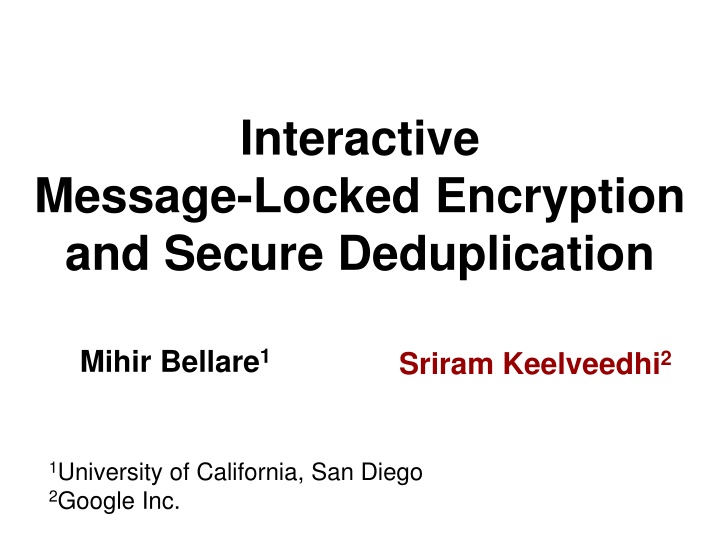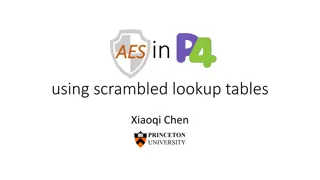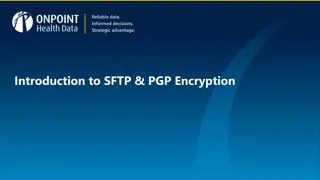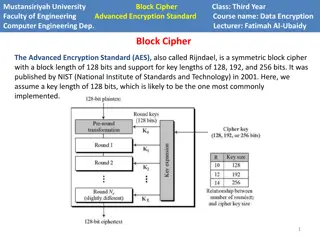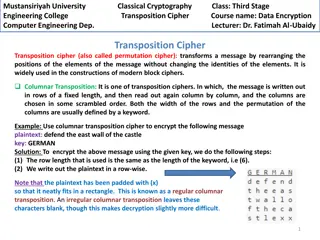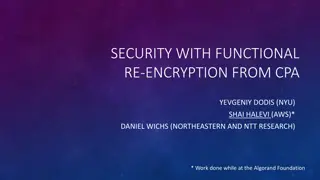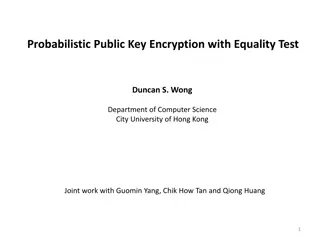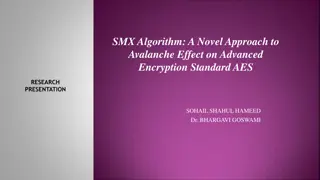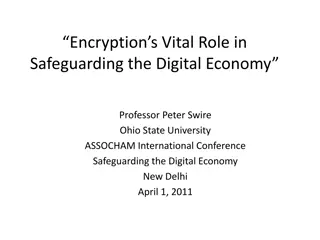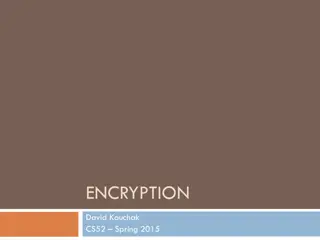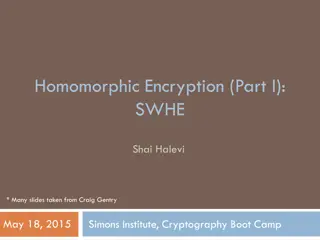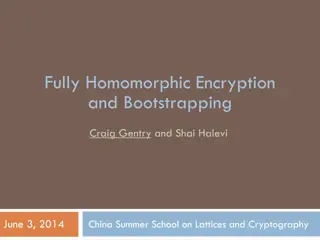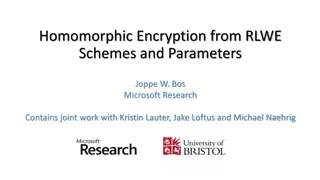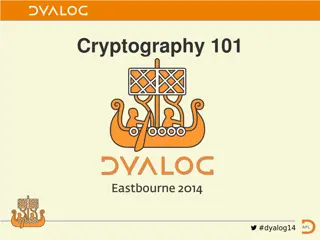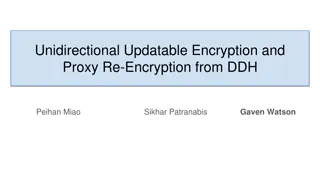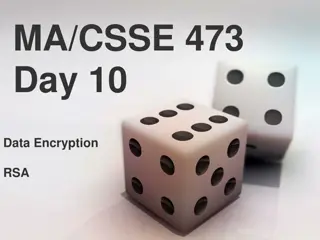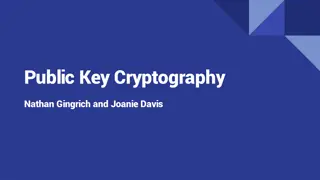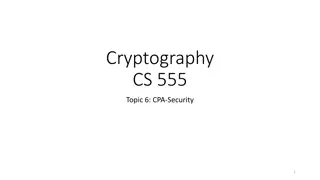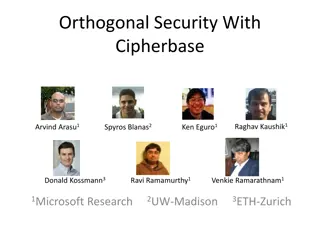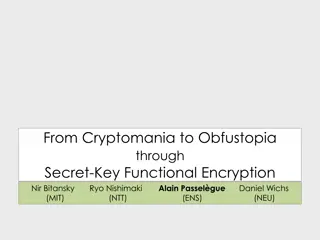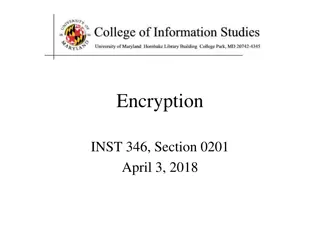Interactive Message-Locked Encryption
This study delves into the realm of interactive message-locked encryption and secure deduplication, emphasizing storage savings, security challenges, and the convergence of cryptographic techniques to enhance data privacy in cloud storage and backup systems.
Download Presentation

Please find below an Image/Link to download the presentation.
The content on the website is provided AS IS for your information and personal use only. It may not be sold, licensed, or shared on other websites without obtaining consent from the author.If you encounter any issues during the download, it is possible that the publisher has removed the file from their server.
You are allowed to download the files provided on this website for personal or commercial use, subject to the condition that they are used lawfully. All files are the property of their respective owners.
The content on the website is provided AS IS for your information and personal use only. It may not be sold, licensed, or shared on other websites without obtaining consent from the author.
E N D
Presentation Transcript
Interactive Message-Locked Encryption and Secure Deduplication Mihir Bellare1 Sriram Keelveedhi2 1University of California, San Diego 2Google Inc.
Deduplication Avoid storing multiple copies of the same data Outsourced storage service Bob Bob Alice Alice Server Server Google Drive Storage savings [MB11] O(n |f|) 87% Backup systems No deduplication O(1 |f|) 50% Corporate networks Deduplication 2
Dedup doesnt work with client-side encryption Bob Bob Alice Alice Server Server Security of symmetric encryption Server has to store both cA and cB Bob cannot decrypt cA Det. PKE [BBO07, MPRS12] Searchable SE [SWP00] Searchable PKE [BBO07] Regular encryption does not work, including { 3
Convergent Encryption H: {0,1}* -> {0,1}k : Cryptographic hash function (E,D): Symmetric encryption scheme with k-bit keys Internet forums [DABST02] Key k is hash of the message H Server Server Bob Bob Alice Alice
Secure deduplication is widely used Cloud storage Farsite [ABCG*02] Filesystems GNUNet Backup [CTP04] [CMN02] [KCP06] Others [BBST01] [MC11] [RCTLL11] [SGLM08] [AZ10] Important to pin down and achieve best possible security for secure dedup 5
Message Locked Encryption [BKR13] Generalizes Convergent Encryption Framework for secure deduplication Key used for encryption is derived from the message itself Message-derived key Parameter Tag All ciphertexts of m produce same deterministic tag t. Deduplication is enabled! 6
Privacy in MLE No efficient adversary can distinguish encryptions of two sets of unpredictable messages Privacy (m0,m1):= D() p:= P(); b:= {0,1} For i = 1 to |mb| ci:= E(K(p, mb[i]), mb[i]) b := A(p, c1,...,cn) A wins if b = b p, c1,...,cn b Adversary A Security: No efficient A has non-negligible advantage for any unpredictable D. Messages have to be unpredictable. But messages can be correlated Necessary: Secret key material should come from somewhere! Caveat: Messages cannot depend on public parameters Not necessary! Not a fundamental impossibility 7
Parameter-dependent security is not fundamentally impossible But why should we care? Messages will depend on public parameters Accidental dependence Adversarially chosen We are targeting best possible security
Getting best possible privacy for secure deduplication Scheme Parameter dependent messages Correlated messages Standard model Convergent encryption [DABST02] N Y N RCE [BHK13] N Y N XtDPKE [BHK13] N N Y [ABMRS13] Y N N This work: FCHECK Y Y Y
Problem: Tags are deterministic, disallow parameter dependence (cf. Deterministic PKE [BBO 07]). How to get rid of tags? Solution: Let s use interaction! Put protocol Get protocol Encrypt procedure Decrypt procedure -- Open up a rich class of constructions -- Substitute det. tags with multi-round protocols -- Use powerful theoretical tools Interaction is not a new addition to the system -- Dedup. systems are interactive by nature
iMLE Scheme = (Init, Register, Put, Get) Init Register Server state Nothing Server Client Updated state Params New client registered, gets params Server state , plaintext Put Server Client Updated state File identifier ? Client starts with plaintext , gets back file identifier ? , ? Server state Get Server Client Updated state Client starts with file identifier ?, gets back plaintext
Correctness 1. Deduplication If a client puts a pre-existing file on the server, storage does not grow by size of file has ciphertext for , plaintext Server state Put Server Client Updated state | | - | | < | | Identifier ? ? 2. Recovery If a client puts a file on the server, the client can get the file later has ciphertext for from the client , ? ? Server state Get Server Client Updated state
Privacy No efficient adversary can distinguish between encryptions of two sets of unpredictable messages even when messages depend on public params Adversary A PRIVACY PRIVACY b {0, 1}; Init() ( , ) Register( ) b A() A wins if b = b State kept in Adversary can: 1. Put messages From any unpredictable distribution Can depend on public parameters Plaintext(d) M0, M1 A(d) For m Mbdo (?, ) Put(m, ) State 2. Learn server s state Return Message(z) Simulate sending message z to the server 3. Run any arbitrary protocol Simulate other clients Put adversarially chosen messages
FCHECK - High level overview Standard model Weak MLE + Fully Homomorphic Encryption = Optimally secure deduplication 1. Weaken MLE to get rid of comparison MLE MLE-Without-Comparison (MLEWC) a. Fully randomized ciphertexts b. Get standard model constructions 2. Use FHE to offset lack of comparison a. Design (an insecure) dedup protocol based on MLEWC b. Use FHE to secure the protocol
MLE-Without-Comparison (MLEWC) MLEWC = (P, K, E, D) Message-derived key Parameter A scheme MLEWC is Weak Privacy secure if no efficient A has non- negligible advantage for any unpredictable D. Weak Privacy (m0,m1):= D(); b:= {0,1} For i = 1 to |mb| pi:= P(); ci:= E(K(pi, mb[i]), mb[i]) b := A(p1,...,pn, c1,...,cn) A wins if b = b
MLEWC in the standard model Construction: Point-function obfuscation scheme* + CR Hash MLEWC * Composable distributional indistinguishable point-function obfuscation scheme Theorem [BC 10]: Point function obfuscators exist in the standard model under the t-Strong Vector Decision Diffie Hellman assumption. Theorem: Weak Privacy secure MLEWC schemes exist in the standard model assuming collision resistant hash functions and point function obfuscation schemes exist in the standard model.
Comparing without tags: An idea 1. Client sends across m 2. Server makes key k from m 3. Server decrypts each of c1 , c2 , , cnwith k 4. Server checks if any of the results is m 5. If no match, server keeps m, otherwise doesn t Server Client m = c1 , c2, , cn Problem: Server learns m Solution: Do the comparison over FHE
Comparing with FHE Fully Homomorphic encryption [G 09] FHE = (K, E, D, Ev) is a fully homomorphic encryption scheme if: 1. (K, E, D) form a regular PKE scheme 2. Ev is the homomorphic evaluation algorithm. For all circuits C, for all valid inputs m1 ,..., mn, when (pk, sk) K() and c1 ,..., cn are encryptions of m1 ,..., mnwith random coins: Pr[D(sk, Ev(C, pk, c1,...,cn)) C(m1,...,mn)] is negligible. The basic comparison circuit Cmp Inputs: plaintext m, params p, ciphertext c, matching index n, current index i Output: New matching index n Cmp(m, p, c, n, i) : If D(K(p, m), c) = m and n = 0 then n i Return n Circuit size is fixed. Server homomorphically runs Cmp on all stored ciphertexts
The (simplified) Put protocol of FCHECK FCHECK[FHE, MLEWC] FHE = (K, E, D, Ev) MLEWC=(P, K , E , D ) Put ((pk, sk), m) Encrypt m with FHE to get c Server Client Put ( ) pk, c Run Cmp homomorphically over all ciphertexts in Server. Track matching index in cn cn Decrypt cn Get match index n n Return nthciphertext c n c n If n = 0 then no match, upload new ciphertext cm cm nf If cm null then add to state, return index nf as file ID Set nfas identifier for m
FCHECK: Correctness and Security FCHECK[FHE, MLEWC] Correctness: Theorem: If MLEWC is a correct MLEWC scheme, and FHE has negligible homomorphic computation error then FCHECK supports deduplication and recovery. Security: Theorem: If MLEWC is a Weak Privacy secure MLEWC scheme and FHE is IND-CPA secure, then FCHECK is a secure iMLE scheme. Deduplication with best possible security: Security for parameter dependent, correlated messages Standard model proof of security
Thanks! Full version at eprint 2015/052
Using interaction Interaction can enable more properties Supporting incremental updates o Described in the paper Combining dedup with proof of possesion o Towards fixing issues described in [HPS 10] Interaction can enable new classes of schemes Substitute FHE with a weaker primitive Practical std. model constructions (without param. dependent security)
Comparing without tags: An idea Server If we did have tags: 1. Client sends t = T(c) where c = E(K(m), m) 2. Server makes tags t1 , t2, , tn from ciphertexts c1 , c2, , cn 3. If t t1 , t2, , tnthen Stop 4. Else client sends c Client m c1 , c2, , cn
Message-Locked Encryption [BKR13] MLE = (P, K, E, D, T) P, K, E: Randomized D, T: Deterministic K D k m E c m p P T t
MLEWC in the standard model Point function: , (x) := if x = else Point function obfuscator OS = (Obf, Eval) Obf { , } F Eval (F, x) ( , ) Correctness: If F := Obf( , ) then Eval(F, x) := if x = else Security: If is drawn from an unpredictable distribution, then for all , outputs of Obf( , ) are indistinguishable from Obf( , ) for random , . Theorem [BC 10]: Point function obfuscators exist in the standard model under the t-Strong Vector Decision Diffie Hellman assumption.
MLEWC in the standard model H: {0,1}* -> {0,1}k : Collision resistant hash function PFO =(Obf, Eval): Point function obfuscation scheme MLEWC = (P, K, E, D) Encryption E: Message-derived key H k c1 ... ci ... cn m1 ... mi ... mn Split into bits Obf m ( k||<i,n>||mi , 0) Decryption D(k, c1,...,cn): For i = 1 to n: If Eval(c, k||<i,n>||0) = 0 then mi:= 0 else mi:= 1 Theorem: MLEWC is a secure MLEWC scheme if H is a collision resistant hash function and PFO is a secure point function obfuscation scheme.
MLEWC in the standard model H: {0,1}* -> {0,1}k : Collision resistant hash function PFO =(Obf, Eval): Point function obfuscation scheme MLEWC = (P, K, E, D) Encryption E: Message-derived key H k c1 ... ci ... cn m1 ... mi ... mn Split into bits Obf m ( k||<i,n>||mi , 0) Decryption D(k, c1,...,cn): For i = 1 to n: If Eval(c, k||<i,n>||0) = 0 then mi:= 0 else mi:= 1 Theorem: MLEWC is a secure MLEWC scheme if H is a collision resistant hash function and PFO is a secure point function obfuscation scheme.
The (simplified) Put protocol of FCHECK FCHECK[FHE, MLEWC] FHE = (K, E, D, Ev) MLEWC=(P, K , E , D ) Put ((pk, sk), m) cf E(pk, m) Server Client Put ( ) pk, cf cr E(pk, 0); cn E(pk, 0); i 0 For (p,c) in do: cp E(pk, p); cc E(pk, c); ci E(pk, i); i i +1 cn Ev(pk, Cmp, cf , cp, cc, cn, ci ) cn n n D(sk, cn) (p,c) [n] p, c If n = 0 then p P(); k K (p, m) c E (k, m) c, p If c null then nf | | + 1; [nf] (p, c) nf Set nfas identifier for m
